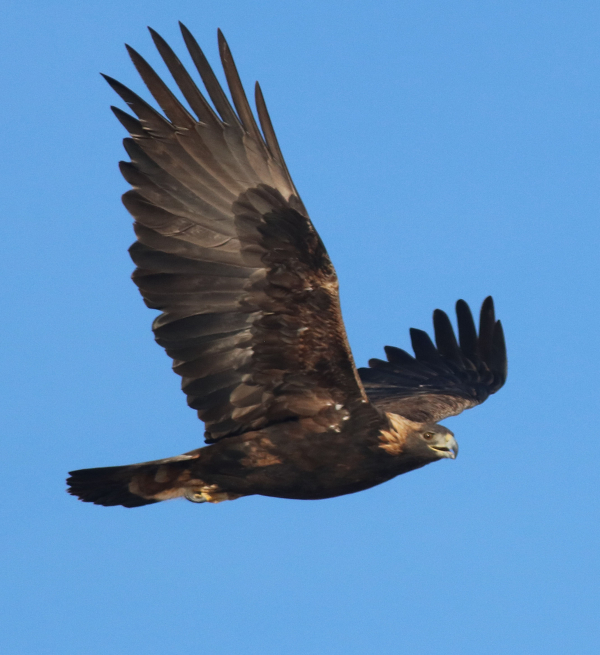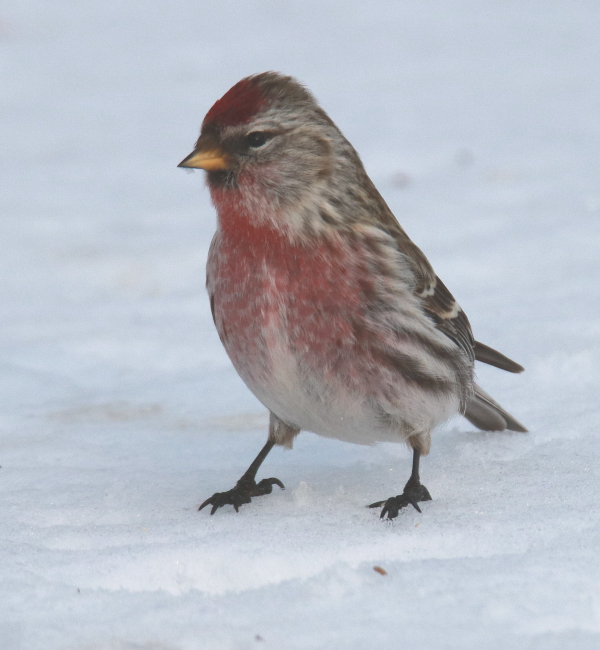
Although they are quite rare in the north of Dakota any time of the year, Golden Eagles were present on consecutive days south and southwest of Bismarck.

Common Redpolls have brightened up the snowy winter days, adding color and lively action.
|
On my way north along the river road to Bismarck, I hoped to find some cold-weather raptors. Bald Eagles should be a given, but there would also be a chance to find a Golden Eagle, Prairie Falcon, Merlin, Rough-legged Hawk, maybe even a Red-tailed Hawk. I checked a couple suspicious outcrops near the top of a few tall buttes, but I felt like I passed through the best areas without a bird to be seen. As I neared a bend in the Missouri River where I watched Bald Eagles soaring a couple months earlier, I could make out 2 eagles flying low over a short coulee filled with winter-bare trees.
My first assumption was Bald Eagles, but they were definitely not adults. A closer look through binoculars showed they were adult Golden Eagles, apparently on the hunt along the coulee, and the river edge. I followed their flights for some minutes before they turned and flew in my direction, passed just behind me, and dipped low above the broad open plain to the east, headed in the general area of a line of high hills above Badger Creek. Well there we go – a pair of hunting Golden Eagles, rare fare in the region any time of year, but more likely during winter. More common were the Ring-necked Pheasants, sighted in groups of 2, 11, 5, 6, 18, and 6.
The next day in Bismarck, my friend Vicki picked me up for a scenic birding drive that took us across the Missouri River and southwest to the rugged terrain and wooded draws along a section of the Heart River Breaks. We locals call this beautiful area “The World” and it provides a level of peaceful reflection among wild landscape punctuated by dramatic ridges and high prairie hills. From a considerable distance I could see an eagle perched on the top of one of the most prominent hills. An initial look through binoculars indicated it was a Golden Eagle, and a second view from a different angle verified that ID.
Black-billed Magpies were the dominant birds throughout area, always a treat to see in full color and in flight. Their unique calls defined the afternoon, and we stopped at the all-but-abandoned Heart River bridge and immediately heard a Downy Woodpecker, which showed its position when it flew from one tree to another. The Golden Eagle was still holding its statuesque position on the peak of the cone-shaped hilltop as we retraced our route through The World, but this time we also appreciated seeing 4 Mule Deer standing atop the adjacent highest hilltop. Of all the times I have visited The World over decades, this was the first time the dramatic double hilltops were topped by the most iconic wildlife of the region, adding to the journey that Victoria and I enjoyed through this special remote destination.
Sharp-shin and Sharp-tail
Thursday as I began to leave home, the wheels on my van hadn’t turned a full rotation before I braked at the sight of a Sharp-shinned Hawk flying at eye level on the hunt, just 40 feet away, flaring in a half-circle turn, then trying to hover for a moment with its tail spread wide and its wings pumping on the edge of a juniper where a few songbirds tried to hide. After that dramatic moment of hesitation, the hawk entered the evergreen, flushing some birds, but remaining inside for a couple ticks of the second hand. Did it catch one of the finches?
Suddenly, the Sharpie bolted across the road, flying like a kamikaze into the bare branches of an elm tree in pursuit of the small songbirds. Momentarily thwarted, the hawk perched in the crotch of the tree trunk, before taking flight again, possibly in pursuit of other birds. This is the fourth visit of a young Sharp-shinned Hawk to my neighborhood that I’ve seen since Christmas, and considering how rare the species is in this region, it is probably the same bird that has stayed in the area for the past month, and hopefully for weeks ahead. That day, the other “local” bird sighting was a lone Sharp-tailed Grouse in flight about 20 miles to the northwest.
Blue Jay Friday!
I was happy to see another Blue Jay at my feeding station Friday after a few jay-less weeks. Because I couldn’t find any of my usual feeder seed mix for a couple weeks, I had to switch to a pure shelled sunflower seed option. But having found a new stock of peanut and shelled sunflower mix earlier in the week, I decided to switch my platform feeder seeds to include the peanuts and other nuts included the “Porch & Patio” shelled sunflower seed mix. It was quickly apparent how much the peanuts were preferred by the Blue Jay, along with Hairy and Downy Woodpeckers.
I took an extended drive during the sunny Friday afternoon that yielded an abundance of Ring-necked Pheasants in groups of 1, 16, 2, 5, and 6, of which a couple provided some nice photos. The only other birds afield were widely scattered Horned Larks numbering 1 to 3 at a time, and a small flock of 7 Common Redpolls. Saturday’s sunny drive showed more scattered Horned Larks, but the jackpot was 3 miles south where I sighted a big flock of 120 Snow Buntings. It was quite fun to watch them, especially when they took flight to reposition a few feet away to scour the snowy ground for seeds.
Finch Fun
At home, there are regularly 10 or 12 Common Redpolls visiting my feeding station along with the usual woodpeckers and nuthatches, but the afore-mentioned Blue Jay turned out to be a one day wonder. Yesterday (Tuesday), during a raging windstorm, as I filled seeds in my hopper and platform feeders, a sharp male redpoll flew in and perched just a foot away from me on the edge of the platform feeder. It allowed me to take a super-close look at the tiny bird, focusing specifically on its bill, eyes, head, feet, and plumage, including its reddish-pink breast coloration. What a wonderful experience; these Arctic finches are certainly trusting I thought. A bit later, I reflected on the interaction, then realized that in addition to be very trusting, the tiny finch was actually using me as a windbreak as I stood between the force of the wind and the feeder – ha-ha. Anything I can do to help, and to be close to a wild bird on its terms.
Speaking of finches, even more Pine Grosbeaks and Evening Grosbeaks are being reported across the Sax-Zim Bog region, along with a host of other exciting birds; and the weatherman is promising the long-standing cloudy sky is breaking up above the Northwoods of Minnesota. So in spite of the prediction of the coldest temperatures of the winter for Thursday morning, the weather report also predicts a sunny day from sunrise to sunset. I’ve been waiting so long for the sun to show northwest of Duluth that I’m driven to give it a try, and I expect to have some exciting birding stories and photos to share with you about my Northwoods adventure in the next issue. As I drive to the Sax-Zim Bog Wednesday, I wish you Happy Ground Hog Day with the hope that spring returns early this year – Happy Birding!
Article and photos by Paul Konrad
Share your bird sightings and photographs at editorstbw2@gmail.com